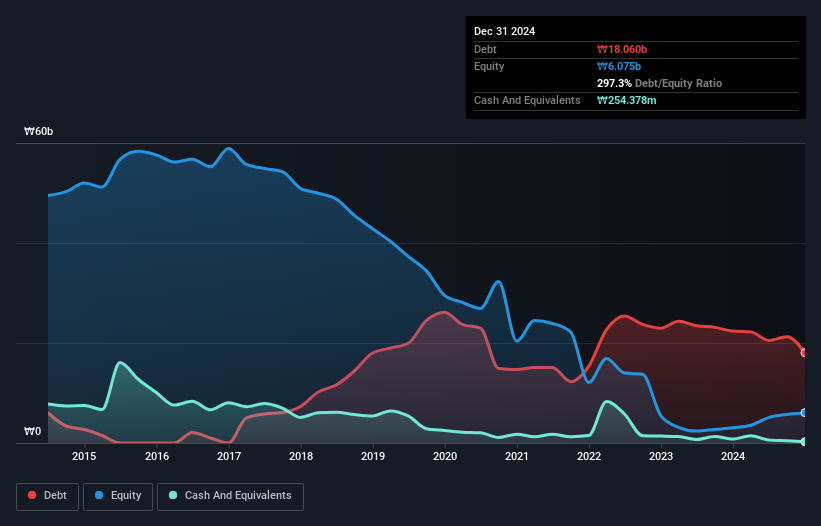- South Korea
- /
- Luxury
- /
- KOSE:A008500
Iljeong IndustrialLtd (KRX:008500) Has A Somewhat Strained Balance Sheet

Howard Marks put it nicely when he said that, rather than worrying about share price volatility, 'The possibility of permanent loss is the risk I worry about... and every practical investor I know worries about.' So it seems the smart money knows that debt - which is usually involved in bankruptcies - is a very important factor, when you assess how risky a company is. Importantly, Iljeong Industrial Co.,Ltd (KRX:008500) does carry debt. But the more important question is: how much risk is that debt creating?
When Is Debt Dangerous?
Debt and other liabilities become risky for a business when it cannot easily fulfill those obligations, either with free cash flow or by raising capital at an attractive price. Part and parcel of capitalism is the process of 'creative destruction' where failed businesses are mercilessly liquidated by their bankers. While that is not too common, we often do see indebted companies permanently diluting shareholders because lenders force them to raise capital at a distressed price. Having said that, the most common situation is where a company manages its debt reasonably well - and to its own advantage. When we examine debt levels, we first consider both cash and debt levels, together.
What Is Iljeong IndustrialLtd's Net Debt?
You can click the graphic below for the historical numbers, but it shows that Iljeong IndustrialLtd had ₩18.1b of debt in December 2024, down from ₩22.4b, one year before. And it doesn't have much cash, so its net debt is about the same.

How Healthy Is Iljeong IndustrialLtd's Balance Sheet?
We can see from the most recent balance sheet that Iljeong IndustrialLtd had liabilities of ₩19.0b falling due within a year, and liabilities of ₩8.05b due beyond that. Offsetting this, it had ₩254.4m in cash and ₩6.91b in receivables that were due within 12 months. So its liabilities total ₩19.9b more than the combination of its cash and short-term receivables.
Given this deficit is actually higher than the company's market capitalization of ₩13.8b, we think shareholders really should watch Iljeong IndustrialLtd's debt levels, like a parent watching their child ride a bike for the first time. Hypothetically, extremely heavy dilution would be required if the company were forced to pay down its liabilities by raising capital at the current share price.
Check out our latest analysis for Iljeong IndustrialLtd
In order to size up a company's debt relative to its earnings, we calculate its net debt divided by its earnings before interest, tax, depreciation, and amortization (EBITDA) and its earnings before interest and tax (EBIT) divided by its interest expense (its interest cover). The advantage of this approach is that we take into account both the absolute quantum of debt (with net debt to EBITDA) and the actual interest expenses associated with that debt (with its interest cover ratio).
While Iljeong IndustrialLtd's debt to EBITDA ratio of 5.1 suggests a heavy debt load, its interest coverage of 7.5 implies it services that debt with ease. Our best guess is that the company does indeed have significant debt obligations. Notably, Iljeong IndustrialLtd made a loss at the EBIT level, last year, but improved that to positive EBIT of ₩2.8b in the last twelve months. The balance sheet is clearly the area to focus on when you are analysing debt. But it is Iljeong IndustrialLtd's earnings that will influence how the balance sheet holds up in the future. So if you're keen to discover more about its earnings, it might be worth checking out this graph of its long term earnings trend.
Finally, a business needs free cash flow to pay off debt; accounting profits just don't cut it. So it is important to check how much of its earnings before interest and tax (EBIT) converts to actual free cash flow. Looking at the most recent year, Iljeong IndustrialLtd recorded free cash flow of 22% of its EBIT, which is weaker than we'd expect. That's not great, when it comes to paying down debt.
Our View
On the face of it, Iljeong IndustrialLtd's net debt to EBITDA left us tentative about the stock, and its level of total liabilities was no more enticing than the one empty restaurant on the busiest night of the year. But on the bright side, its interest cover is a good sign, and makes us more optimistic. We're quite clear that we consider Iljeong IndustrialLtd to be really rather risky, as a result of its balance sheet health. So we're almost as wary of this stock as a hungry kitten is about falling into its owner's fish pond: once bitten, twice shy, as they say. When analysing debt levels, the balance sheet is the obvious place to start. However, not all investment risk resides within the balance sheet - far from it. We've identified 2 warning signs with Iljeong IndustrialLtd , and understanding them should be part of your investment process.
Of course, if you're the type of investor who prefers buying stocks without the burden of debt, then don't hesitate to discover our exclusive list of net cash growth stocks, today.
New: AI Stock Screener & Alerts
Our new AI Stock Screener scans the market every day to uncover opportunities.
• Dividend Powerhouses (3%+ Yield)
• Undervalued Small Caps with Insider Buying
• High growth Tech and AI Companies
Or build your own from over 50 metrics.
Have feedback on this article? Concerned about the content? Get in touch with us directly. Alternatively, email editorial-team (at) simplywallst.com.
This article by Simply Wall St is general in nature. We provide commentary based on historical data and analyst forecasts only using an unbiased methodology and our articles are not intended to be financial advice. It does not constitute a recommendation to buy or sell any stock, and does not take account of your objectives, or your financial situation. We aim to bring you long-term focused analysis driven by fundamental data. Note that our analysis may not factor in the latest price-sensitive company announcements or qualitative material. Simply Wall St has no position in any stocks mentioned.
About KOSE:A008500
Iljeong IndustrialLtd
Iljeong Industrial Co.Ltd. provides car seat fabrics to automobile makers in Korea.
Solid track record low.
Market Insights
Community Narratives



